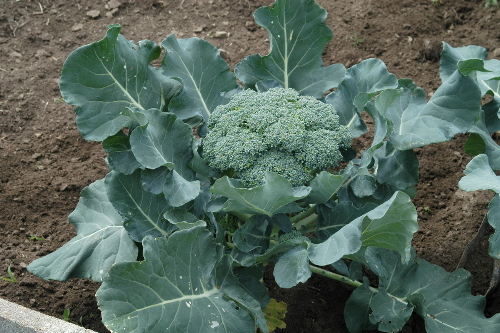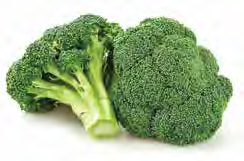Broccoli

Broccoli is a cool-season vegetable that can be grown in both the spring and the fall. Common broccoli forms a large head of immature flower buds. Other types of broccoli develop smaller shoots of buds.
- Sprouting broccoli. Sprouting broccoli is another type of broccoli that produces lots of smaller side shoots rather than one large central head. In most cases, it is recommended to pinch out the central floret/ head when it appears to induce more side shoots. There are both green and purple varieties. There are also some varieties that are designed for winter harvesting in mild areas, which may not perform well in Kansas. Look for varieties with shorter days to maturity.
- Broccoli rabe. Broccoli rabe is also called broccoli raab or rapini. This vegetable has florets that look like broccoli but does not form a large head. It is more closely related to turnips than to traditional broccoli and has a stronger, more pungent flavor. It is fast-maturing and not very heat tolerant.
- Chinese broccoli. Chinese broccoli is also called Gai Lan or Kailaan. While it develops small flower buds, similar to sprouting broccoli or broccoli rabe, it is usually harvested for the thick, fleshy stalks and tender leaves that grow around the buds.
Para información en español, visite este sitio web.
For a spring crop, look for varieties that are fast maturing and maintain good head quality in hot weather. For a fall crop, look for early maturing varieties that also have good cold tolerance. Some varieties will produce side shoots after the main head is harvested. While you can direct seed broccoli into the garden, it is better to start the seeds indoors and then plant the transplants outdoors. Seeds should be started 5-7 weeks before planting. In the spring broccoli can be planted outdoors starting in mid-March to mid- April. For a fall crop plant broccoli transplants in late July through early August for best results. Broccoli should be planted 18 to 24 inches apart. If planting in rows, allow 36 inches between rows.
- Sunlight: Broccoli prefers full sun however some shade in the afternoon will slow down bolting.
- Temperature: Once Broccoli is acclimated to the cold it is very cold hardy and will tolerate temperatures below freezing but it does not tolerate high temperatures. Broccoli will bolt or flower when the temperatures get too warm.
- Watering: Broccoli needs at least one inch of moisture every week. To produce sweet, flavorful, firm, non-bitter heads, the plants must not experience water stress. If the plants do not receive consistent rainfall or irrigation, they may form small, disappointing, off-flavored heads.
- Soil and Fertilization: Broccoli prefers well-drained soil with adequate nutrients. The addition of organic material prior to planting can provide nutrients. Fertilize broccoli at planting. Side dress broccoli with a nitrogen fertilizer three weeks after planting transplants outdoors. Sprinkle additional fertilizer along the row every 2 to 3 weeks as the crop develops.
- Transplanting: Select broccoli plants that are small and stocky. Avoid tall, spindly plants. Weak, tall plants often “bolt” or produce a premature head, which will never enlarge. Be sure to acclimate transplants outdoors for a week or ten days prior to planting. Set the plants outside in a protected area and slowly get them used to sun and wind by moving them out of the protected area.
- Pests and Issues: Cabbage worms and other insects are some of the biggest pests of broccoli. The easiest way to prevent these insect issues is to use floating row covers over the top of the plants to exclude the pests. Over-fertilization of broccoli plants can increase the severity of aphid infestations. Bolting is another common issue, however there is no cure for as this is the plants response to warm temperatures.
- Succession Planting: Plant broccoli transplants every couple of weeks or plant multiple varieties to have a longer season of harvest.
Harvest the head with a sharp knife when heads reach a usable size, while they are still tight before the flowers start to open or before yellow centers of the flowers start to show. Usually 4 to 5 inches of the stem is also tender and can be used with the head. Continue to cut small side heads until hot weather causes them to be strongly flavored or until a hard freeze kills the plant. Broccoli will continue to grow even after light frost in the fall. No matter the weather, harvest promptly once it is mature, as it does not keep its quality. If you miss the chance to harvest, and flowers are beginning to open, immediately cut the head. Broccoli will keep for 10 to 14 days if stored at 32 degrees Fahrenheit with 95 to 100 percent humidity. Broccoli can be preserved by freezing it. For information on freezing broccoli visit the University of Georgia Center for Home Food Preservation.
tight before the flowers start to open or before yellow centers of the flowers start to show. Usually 4 to 5 inches of the stem is also tender and can be used with the head. Continue to cut small side heads until hot weather causes them to be strongly flavored or until a hard freeze kills the plant. Broccoli will continue to grow even after light frost in the fall. No matter the weather, harvest promptly once it is mature, as it does not keep its quality. If you miss the chance to harvest, and flowers are beginning to open, immediately cut the head. Broccoli will keep for 10 to 14 days if stored at 32 degrees Fahrenheit with 95 to 100 percent humidity. Broccoli can be preserved by freezing it. For information on freezing broccoli visit the University of Georgia Center for Home Food Preservation.
Broccoli can help reduce the risk of some forms of cancer and heart disease. It also keeps bones, eyes, and teeth strong. Choose bright green or purplish-green heads. Leaves and stems should be dark green. Stalk should be tender and firm with compact buds. Serve broccoli raw or cooked. Steam, boil, or simmer in a little water, or microwave for the shortest time possible. Overcooked broccoli loses nutrients. Add broccoli to soups, salads, casseroles and stir-fries.
Creamy Broccoli and Apple Salad
| Ingredients | Directions |
|
|
Recipe source: North Dakota State University Extension
Broccoli Cheese Soup
| Ingredients | Directions |
|
|
Recipe source: University of Florida Extension
Broccoli Cheddar Crescent Ring
| Ingredients | Directions |
|
|
Recipe source: Food Network